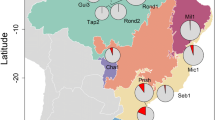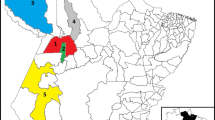Abstract
The habits of birds make them more or less susceptible to parasitism by certain tick species. Therefore, while some bird species are typically found to be intensely infested, others are relatively unaffected. This study investigated the occurrence of ticks in Passeriformes inhabiting an Atlantic Forest fragment in southeastern Brazil, during the dry and rainy seasons, by means of parasitological indexes and multiple correspondence analysis, to determine the factors that influence tick parasitism in these birds. Data were collected on 2391 ticks, all classified in the Amblyomma genus, from 589 birds. The ticks identified to the species level were A. longirostre, A. nodosum, A. calcaratum, A. parkeri, and A. ovale. Thamnophilidae, Conopophagidae, Thraupidae, Dendrocolaptidae, and Platyrinchidae were the families with the highest prevalence. In terms of parasite intensity, the families Conopophagidae, Thamnophilidae, Thraupidae, Furnariidae, and Pipridae stood out with the highest values. Bird species that are generalists regarding eating habits and habitat occupation tended to have higher parasite loads, as did larger species and those inhabiting the understory. The tick prevalence was higher in the dry season than in the rainy season. The majority of the ticks were collected from the head region, mainly around the eyes and in the nape. Also, this work reports 22 new bird-parasite relations.





Similar content being viewed by others
References
Aguilar TM, Maldonado-Coelho M, Marini MÂ (2000) Nesting biology of the gray-hooded flycatcher (Mionectes rufiventris). Ornitol Neotrop 11:223–230
Amaral HLC, Bergmann FB, dos Santos PRS et al (2013) Community of arthropod ectoparasites of two species of Turdus Linnaeus, 1758 (Passeriformes: Turdidae) in southern Rio Grande do Sul, Brazil. Parasitol Res 112:621–628
Arzua M, Navarro da Silva MA, Famadas KM et al (2003) Amblyomma aureolatum and Ixodes auritulus (Acari: Ixodidae) on birds in southern Brazil, with notes on their ecology. Exp Appl Acarol 31:283–296
Arzua M, Onofrio VC, Barros-Battesti DM (2005) Catalogue of the tick collection (Acari, Ixodida) of the Museu de História Natural Capão da Imbuia, Curitiba, Paraná, Brazil. Rev Bras Zool 22:623–632
Auer S, Bassar R, Fontaine J, Martin T (2007) Breeding biology of passerines in a subtropical montane forest in northwestern Argentina. The Condor 109:321–333
Bush AO, Lafferty KD, Lotz JM, Shostak AW (1997) Parasitology meets ecology on its own terms: Margolis et al. revisited. J Parasitol 83:575–583
CBRO Comitê Brasileiro de Registros Ornitológicos. http://www.cbro.org.br/.
Choi C-Y, Kang C-W, Kim E-M et al (2014) Ticks collected from migratory birds, including a new record of Haemaphysalis formosensis, on Jeju Island, Korea. Exp Appl Acarol 62:557–566
Clayton DH, Koop JAH, Harbison CW et al (2010) How birds combat ectoparasites. Open Ornithol J 3:41–71
Clifford CM, Anastos G, Elbl A (1961) The larval ixodid ticks of the Eastern United States (Acarina-Ixodidae). Misc Publ Entomol Soc Am 2(3):213–237
Dunn EH, Ralph CJ (2004) Use of mist nets as a tool for bird population monitoring. In: Ralph CJ, Dunn EH (eds) Monitoring bird populations using mist nets–studies in avian biology, vol 29. Cooper Ornithological Society, Ephrata, pp 1–6
Dusbabek F (2002) Adaptation of mites and ticks to parasitism. Medical and veterinary aspects. In: Bernini F, Nannelli R, Nuzzaci G, de Lillo E (eds) Acarid phylogeny and evolution: adaptation in mites and ticks. Springer, Netherlands, pp 399–418
Estrada-Peña A, de la Fuente J (2014) The ecology of ticks and epidemiology of tick-borne viral diseases. Antivir Res 108:104–128
Figueiredo LTM, Badra SJ, Pereira LE, Szabó MPJ (1999) Report on ticks collected in the Southeast and Mid-West regions of Brazil: analyzing the potential transmission of tick-borne pathogens to man. Revista da Sociedade Brasileira de Medicina Tropical 32:613–619
Godoy FLD (2011) Composição e estrutura de bandos mistos de aves em uma área de plantio de eucalipto (Eucalyptus sp.). Atual Ornitol 163:43–47
Guglielmone AA, Robbins RG, Apanaskevich DA et al (2014) The hard ticks of the world: (Acari: Ixodida: Ixodidae). Springer London, Limited
Hasle G (2013) Transport of ixodid ticks and tick-borne pathogens by migratory birds. Front Cell Infect Microbio 3:48
Labruna MB, Sanfilippo LF, Demetrio C et al (2007) Ticks collected on birds in the state of São Paulo, Brazil. Exp Appl Acarol 43:147–160
Labruna MB, Terassini FA, Camargo LMA (2009) Notes on population dynamics of Amblyomma ticks (Acari: Ixodidae) in Brazil. Journal of Parasitology 95(4):1016–1018
Lê S, Josse J, Husson F (2008) FactoMineR: an R package for multivariate analysis. J Stat Softw 25(1):1–18
Lill A, Ffrench RP (1970) Nesting of the plain Antvireo Dysithamnus mentalis Andrei in Trinidad, West Indies. Ibis 112:267–268
Lima LM (2014) Birds of the Atlantic Forest: richness, status, composition, endemism, and conservation. Dissertation, Universidade de São Paulo
Lopes LE, Fernandes AM, Marini MÂ (2005) Diet of some Atlantic Forest birds. Ararajuba 1:95–103
Lugarini C, Martins TF, Ogrzewalska M, de Vasconcelos NCT, Ellis VA, de Oliveira JB, Pinter A, Labruna MB, Silva JCR (2014) Rickettsial agents in avian ixodid ticks in northeast Brazil. Ticks Tick-borne Dis doi:10.1016/j.ttbdis.2015.02.011
Luz HR, Faccini JLH, Landulfo GA et al (2012) Bird ticks in an area of the Cerrado of Minas Gerais State, southeast Brazil. Exp Appl Acarol 58:89–99
Manhães MA (2007) Ecologia trófica de aves de sub-bosque em duas áreas de Mata Atlântica no sudeste do Brasil. Universidade Federal de São Carlos, São Carlos
Manhães MA, Assis LCS, Castro RM (2005) Frugivoria e dispersão de sementes de Miconia urophylla (Melastomataceae) por aves em um fragmento de Mata Atlântica secundária em Juiz de Fora, Minas Gerais, Brasil. Ararajuba 2:173–180
Manhães MA, Loures-Ribeiro A, Dias MM (2010) Diet of understorey birds in two Atlantic Forest areas of southeast Brazil. J Nat Hist 44:469–489
Marini MA, Reinert BL, Bornschein MR et al (1996) Ecological correlates of ectoparasitism on Atlantic Forest birds, Brazil. Ararajuba 4:93–102
Marini MÂ, Lopes LE, Fernandes AM, Sebaio F (2002) Descrição de um ninho de Lepidocolaptes fuscus (Dendrocolaptidae) do nordeste de Minas Gerais, com dados sobre sua dieta e pterilose dos ninhegos. Ararajuba 10:95–98
Marini MÂ, Aguilar TM, Andrade RD et al (2007) Biologia da nidificação de aves do sudeste de Minas Gerais, Brasil. Rev Bras Ornitol 15:367–376
Marshall AG (1981) The ecology of ectoparasitic insects. Academic, London
Martins TF, Onofrio VC, Barros-Battesti DM, Labruna MB (2010) Nymphs of the genus Amblyomma (Acari: Ixodidae) of Brazil: descriptions, redescriptions, and identification key. Ticks and Tick-Borne Diseases 1(2):75–99
Medri ÍM, Mourão G, Rodrigues FHG (2006) Ordem Xenarthra. Mamíferos do Brasil. Universidade Estadual de Londrina, Londrina, pp 71–94
Nava S, VELAZCO PM, Guglielmone AA (2010) First record of Amblyomma longirostre (Koch, 1844) (Acari: Ixodidae) from Peru, with a review of this tick’s host relationships. Syst Appl Acarol 15:21–30
Ogrzewalska M, Pacheco RC, Uezu A et al (2008) Ticks (Acari: Ixodidae) infesting wild birds in an Atlantic forest area in the state of São Paulo, Brazil, with isolation of Rickettsia from the tick Amblyomma longirostre. J Med Entomol 45:770–774
Ogrzewalska M, Pacheco RC, Uezu A et al (2009a) Ticks (Acari: Ixodidae) infesting birds in an Atlantic rain forest region of Brazil. J Med Entomol 46:1225–1229
Ogrzewalska M, Pacheco RC, Uezu A et al (2009b) Rickettsial infection in Amblyomma nodosum ticks (Acari: Ixodidae) from Brazil. Ann Trop Med Parasitol 103:413–425
Ogrzewalska M, Uezu A, Labruna M (2010) Ticks (Acari: Ixodidae) infesting wild birds in the eastern Amazon, northern Brazil, with notes on rickettsial infection in ticks. Parasitol Res 106:809–816
Ogrzewalska M, Uezu A, Jenkins C, Labruna M (2011a) Effect of forest fragmentation on tick infestations of birds and tick infection rates by Rickettsia in the Atlantic Forest of Brazil. EcoHealth 8:320–331
Ogrzewalska M, Uezu A, Labruna MB (2011b) Ticks (Acari: Ixodidae) infesting wild birds in the Atlantic Forest in northeastern Brazil, with notes on rickettsial infection in ticks. Parasitol Res 108:665–670
Ogrzewalska M, Saraiva DG, Moraes-Filho J et al (2012) Epidemiology of Brazilian spotted fever in the Atlantic Forest, state of São Paulo, Brazil. Parasitol 139:1283–1300
Ogrzewalska M, Martins T, Capek M et al (2013) A Rickettsia parkeri-like agent infecting Amblyomma calcaratum nymphs from wild birds in Mato Grosso do Sul, Brazil. Ticks and Tick-borne Dis 4:145–147
Oliveira JA, Bonvicino CR (2006) Ordem Rodentia. Mamíferos do Brasil. Universidade Estadual de Londrina, Londrina, pp 347–406
Oliveira-Filho AT, Tameirão-Neto E, Warley AC et al (2005) Análise florística do compartimento arbóreo de áreas de floresta atlântica sensu lato na região das Bacias do Leste (Bahia, Minas Gerais, Espírito Santo e Rio de Janeiro). Rodriguésia 56:185–235
Onofrio VC, Labruna MB, Pinter A et al (2006) Comentários e chaves para as espécies do gênero Amb/yomma. Carrapatos de importância médico-veterinária da Região Neotropical: Um guia ilustrado para identificação de espécies., pp 53–114
Pacheco RC, Arzua M, Nieri-Bastos FA et al (2012) Rickettsial infection in ticks (Acari: Ixodidae) collected on birds in southern Brazil. J Med Entomol 49:710–716
Parrini R, Raposo MA (2008) Associação entre aves e flores de duas espécies de árvores do gênero Erythrina (Fabaceae) na Mata Atlântica do sudeste do Brasil. Iheringia Série Zoologia 98(1):123–128
Pascoal JD, Amorim MD, Martins MM, Melo C, da Silva EL, Ogrzewalska M, Labruna MB, Szabo MPJ (2013) Ticks on birds in a savanna (Cerrado) reserve on the outskirts of Uberlandia, Minas Gerais, Brazil. Revista Brasileira De Parasitologia Veterinaria 22(1):46–52
Poulin R (1993) The disparity between observed and uniform distributions: a new look at parasite aggregation. Intern J Parasitol 23:937–944
R Core Team (2014) R: a language and environment for statistical computing. R Foundation for Statistical Computing, Vienna
Reiczigel J, Rozsa L, Reiczigel A (2013) Quantitative parasitology (QPweb)
Ridgely RS, Tudor G (2009) Field guide to the songbirds of South America: the Passerines. University of Texas Press, Austin
Sanches GS, Martins TF, Lopes IT et al (2013) Ticks infesting birds in Atlantic Forest fragments in Rio Claro, State of Sao Paulo, Brazil. Rev Bras Parasitol Vet 22:6–12
Santolin ÍDAC, Luz HR, Alchorne NM et al (2012) Ticks on birds caught on the campus of the Federal Rural University of Rio de Janeiro. Brazil Rev Bras Parasitol Vet 21:213–218
Sick H (1997) Ornitologia brasileira. Editora Nova Fronteira
Sigrist T (2012) Iconografia das aves do Brasil: Mata Atlântica. Avis Brasilis Editora
Sigrist T, Brettas E (2009) Avifauna brasileira: descrição das espécies. Avis Brasilis Editora
Sonenshine DE, Mather TN (1994) Ecological dynamics of tick-borne zoonoses. Oxford University Press, USA
Sonenshine DE, Stout IJ (1970) A contribution to the ecology of ticks infesting wild birds and rabbits in the Virginia-North Carolina Piedmont (Acarina: Ixodidae). J Med Entomol 7:645–654
SOSMA, INPE (2014) Atlas dos remanescentes florestais da Mata Atlântica período 2012–2013., p 61
Stotz DF, International C, History FM of N (1996) Neotropical birds: ecology and conservation. University of Chicago Press, Chicago
Tolesano-Pascoli GV, Torga K, Franchin AG et al (2010) Ticks on birds in a forest fragment of Brazilian cerrado (savanna) in the municipality of Uberlândia, State of Minas Gerais, Brazil. Rev Bras Parasitol Vet 19:244–248
Torga K, Tolesano-Pascoli G, Vasquez JB et al (2013) Ticks on birds from Cerrado forest patches along the Uberabinha river in the Triângulo Mineiro region of Minas Gerais, Brazil. Ciênc Rural 43:1852–1857
Willis EO (1979) The composition of avian communities in remanescent woodlots in southern Brazil. Pap Avulsos Zool 33:1–25
Willis EO, Oniki Y, Silva WR (1983) On the behaviour of rufous gnateaters (Conopophaga lineata, Formicariidae). Naturalia 8:67–83
Acknowledgments
We are thankful to the owners of Fazenda Continente for allowing us to perform this work. This work was supported by Coordenação de Aperfeiçoamento de Pessoal de Nível Superior (CAPES–MEC) and Conselho Nacional de Desenvolvimento Científico e Tecnológico (CNPq).
Author information
Authors and Affiliations
Corresponding author
Rights and permissions
About this article
Cite this article
Maturano, R., Faccini, J.L.H., Daemon, E. et al. Additional information about tick parasitism in Passeriformes birds in an Atlantic Forest in southeastern Brazil. Parasitol Res 114, 4181–4193 (2015). https://doi.org/10.1007/s00436-015-4651-4
Received:
Accepted:
Published:
Issue Date:
DOI: https://doi.org/10.1007/s00436-015-4651-4




